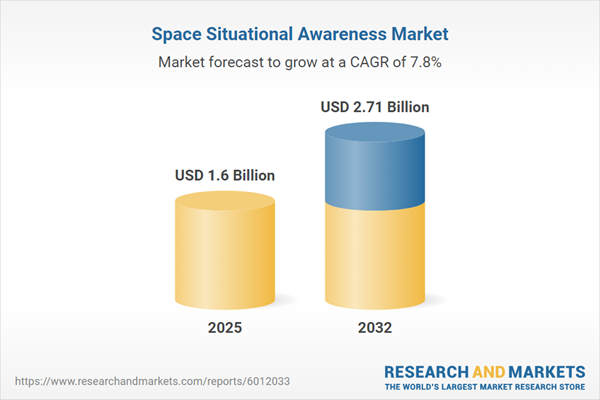Speak directly to the analyst to clarify any post sales queries you may have.
Senior decision-makers in the global space sector face mounting challenges as orbital environments grow more complex and contested. The Space Situational Awareness Market offers essential intelligence and strategic frameworks to help organizations maintain mission-critical safety, continuity, and competitiveness.
Market Snapshot: Space Situational Awareness Market Overview
The Space Situational Awareness Market grew from USD 1.48 billion in 2024 to USD 1.60 billion in 2025. It is expected to continue growing at a CAGR of 7.80%, reaching USD 2.71 billion by 2032. These figures reveal a sector experiencing steady expansion as investments in orbital safety and monitoring intensify, propelled by technological innovation, evolving risks, and increased commercial and governmental activity. As orbits become more crowded, demand for collision avoidance, advanced tracking, and robust data analytics is reshaping industry priorities and stakeholder strategies.
Scope & Segmentation
- Service Types: Conjunction assessment and collision avoidance, data analytics and reporting, monitoring and tracking, space debris removal.
- Component Types: Communication systems (including antennas and transponders), power systems, processing units (hardware processors and software solutions), sensor systems (infrared, optical, and radar sensors).
- Platform Types: Ground stations, mobile tracking units, satellite platforms (large, medium, and small satellites).
- Deployment Modes: Ground based, space based.
- End Users: Commercial enterprises, defense organizations, government agencies, research institutions.
- Regions:
- Americas: United States, Canada, Mexico, Brazil, Argentina, Chile, Colombia, Peru
- Europe, Middle East & Africa: United Kingdom, Germany, France, Russia, Italy, Spain, Netherlands, Sweden, Poland, Switzerland, United Arab Emirates, Saudi Arabia, Qatar, Turkey, Israel, South Africa, Nigeria, Egypt, Kenya
- Asia-Pacific: China, India, Japan, Australia, South Korea, Indonesia, Thailand, Malaysia, Singapore, Taiwan
- Companies Profiled: ANSYS, Astroscale, Elecnor Deimos, Electro Optic Systems Holdings, ExoAnalytic Solutions, GlobVision, GMV Innovating Solutions, Kratos Defense & Security Solutions, L3Harris Technologies, Launchspace Technologies, Lockheed Martin, NorthStar Earth & Space, Parsons Corporation, Peraton, Share My Space, SpaceNav, Swedish Space Corporation, Telespazio, The Aerospace Corporation, Vision Engineering Solutions, DA-Group, LeoLabs, Aireon, Orbitform, Orbit Logic by Boecore.
Key Takeaways for Decision Makers
- Advanced technologies such as artificial intelligence and miniaturized sensor systems are accelerating real-time threat detection and enabling automated response protocols.
- Growth in both commercial and governmental satellite launches has led to increased emphasis on collision avoidance solutions and persistent orbital monitoring.
- Regional market trajectories are shaped by differing regulatory frameworks, funding models, and infrastructure investment, requiring tailored approaches for each geography.
- Strategic partnerships across defense, academia, and commercial sectors drive cross-domain innovation, process optimization, and resilience in orbital operations.
- Emerging players are disrupting traditional pricing models, making access to high-fidelity space situational data more achievable for organizations of various sizes.
- Organizations with agile procurement and modular design strategies are better equipped to navigate evolving policy landscapes and supply chain disruptions.
Tariff Impact on Supply Chain and Collaboration
- Recent tariff adjustments in the United States have prompted vendors to adapt by sourcing components locally and considering nearshoring, affecting procurement cycles and vendor risk management.
- International partnerships are realigning to offset cost impacts, with more focus on local manufacturing and technology transfer, prompting shifts in technology development and regional collaboration.
- Space system integrators are increasing in-house R&D efforts to shield key projects from trade policy volatility and strengthen domestic capabilities.
Methodology & Data Sources
This report integrates quantitative data from operational sensor networks, real-time satellite telemetry, and debris tracking archives, normalized for consistency. Qualitative insights stem from expert interviews and technical workshops, with rigorous cross-referencing and triangulation to validate findings.
Why This Report Matters
- It equips executive leadership with scenario-based, actionable strategies for safeguarding critical missions in dynamically changing orbital environments.
- Stakeholders gain in-depth understanding of evolving regional regulations, supply chain risks, and emerging technologies to inform strategic investment.
- The analysis provides a roadmap for modular system design, resilient collaboration models, and proactive risk management tailored to space operations.
Conclusion
The Space Situational Awareness Market is undergoing robust transformation as technology, policy, and operational complexity converge. This report delivers the clarity required to future-proof investments, optimize resource allocation, and advance resilient orbital strategies.
Additional Product Information:
- Purchase of this report includes 1 year online access with quarterly updates.
- This report can be updated on request. Please contact our Customer Experience team using the Ask a Question widget on our website.
Table of Contents
3. Executive Summary
4. Market Overview
7. Cumulative Impact of Artificial Intelligence 2025
Companies Mentioned
The companies profiled in this Space Situational Awareness market report include:- ANSYS, Inc.
- Astroscale Holdings Inc.
- Elecnor Deimos
- Electro Optic Systems Holdings Limited
- ExoAnalytic Solutions, Inc.
- GlobVision Inc.
- GMV Innovating Solutions, S.L.
- Kratos Defense & Security Solutions, Inc.
- L3Harris Technologies, Inc.
- Launchspace Technologies Corporation
- Lockheed Martin Corporation
- NorthStar Earth & Space Inc.
- Parsons Corporation
- Peraton Corp.
- Share my space
- SpaceNav
- Swedish Space Corporation
- Telespazio S.p.A.
- The Aerospace Corporation
- Vision Engineering Solutions, LLC
- DA-Group
- LeoLabs, Inc.
- Aireon LLC
- Orbitform, LLC
- Orbit Logic by Boecore, Inc.
Table Information
| Report Attribute | Details |
|---|---|
| No. of Pages | 187 |
| Published | November 2025 |
| Forecast Period | 2025 - 2032 |
| Estimated Market Value ( USD | $ 1.6 Billion |
| Forecasted Market Value ( USD | $ 2.71 Billion |
| Compound Annual Growth Rate | 7.8% |
| Regions Covered | Global |
| No. of Companies Mentioned | 26 |









